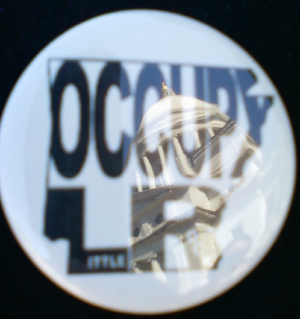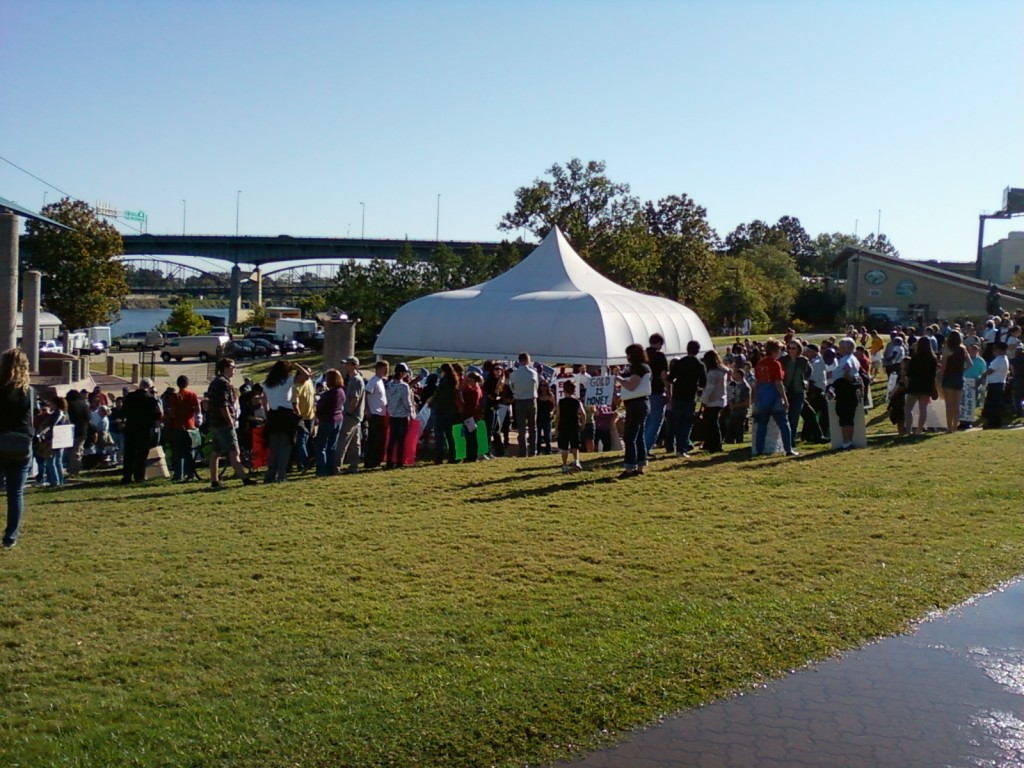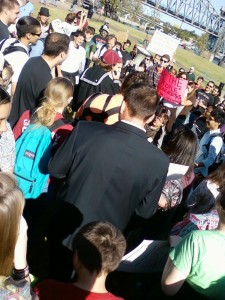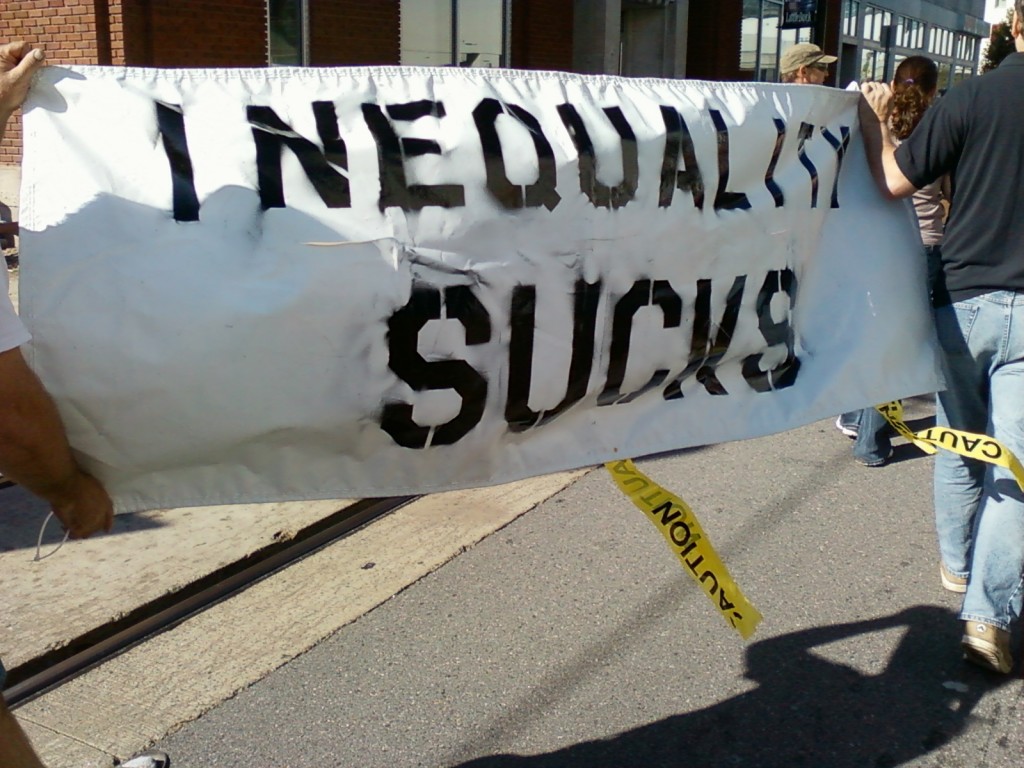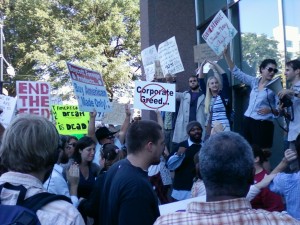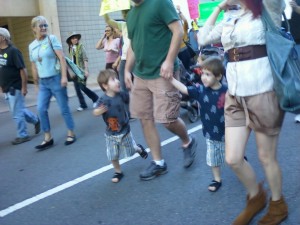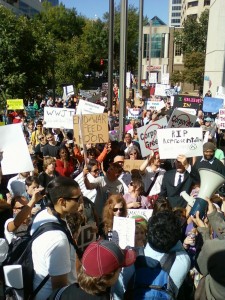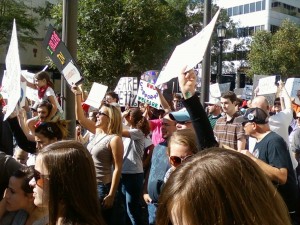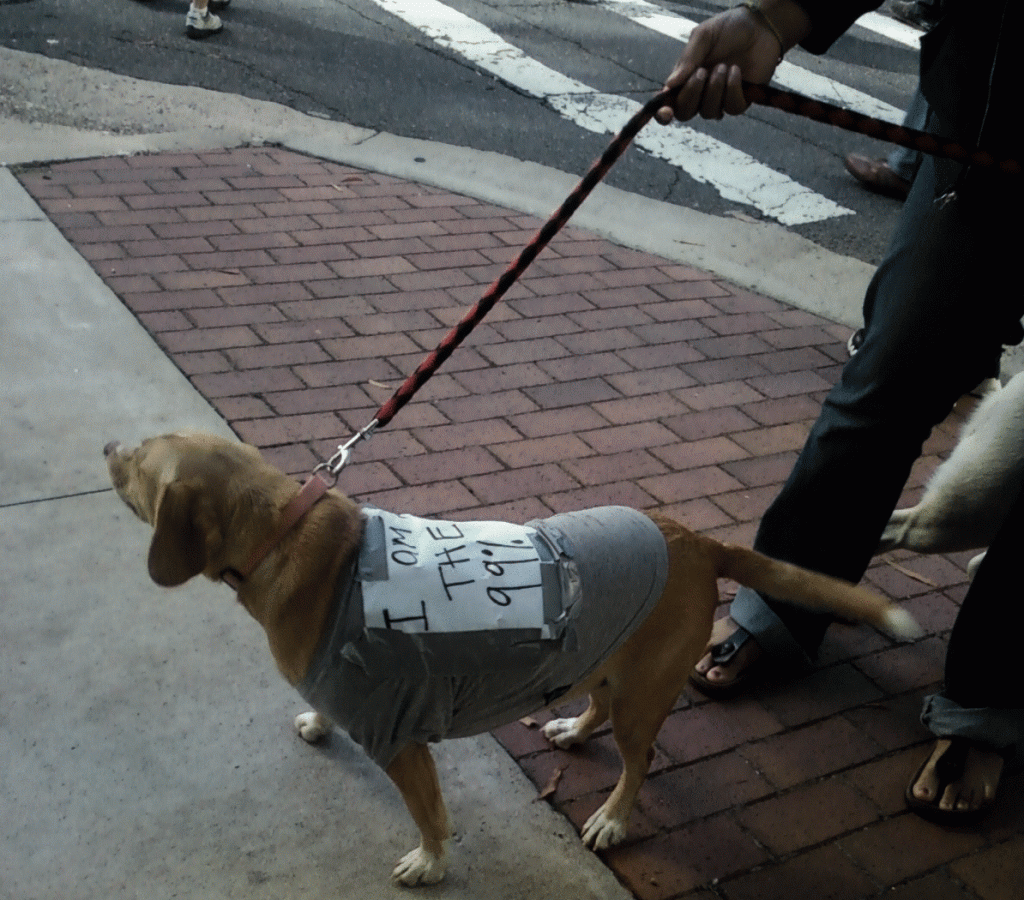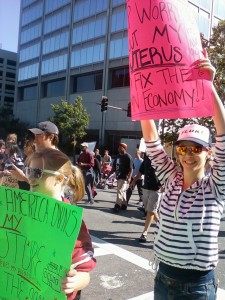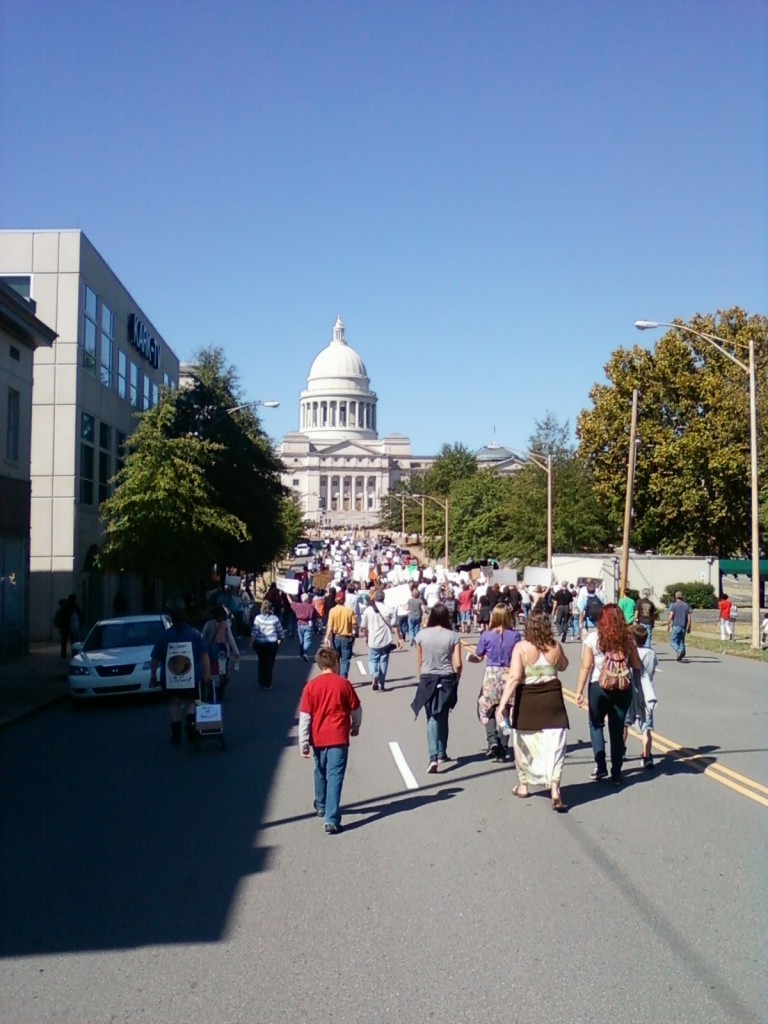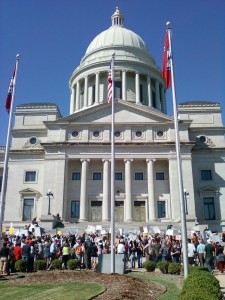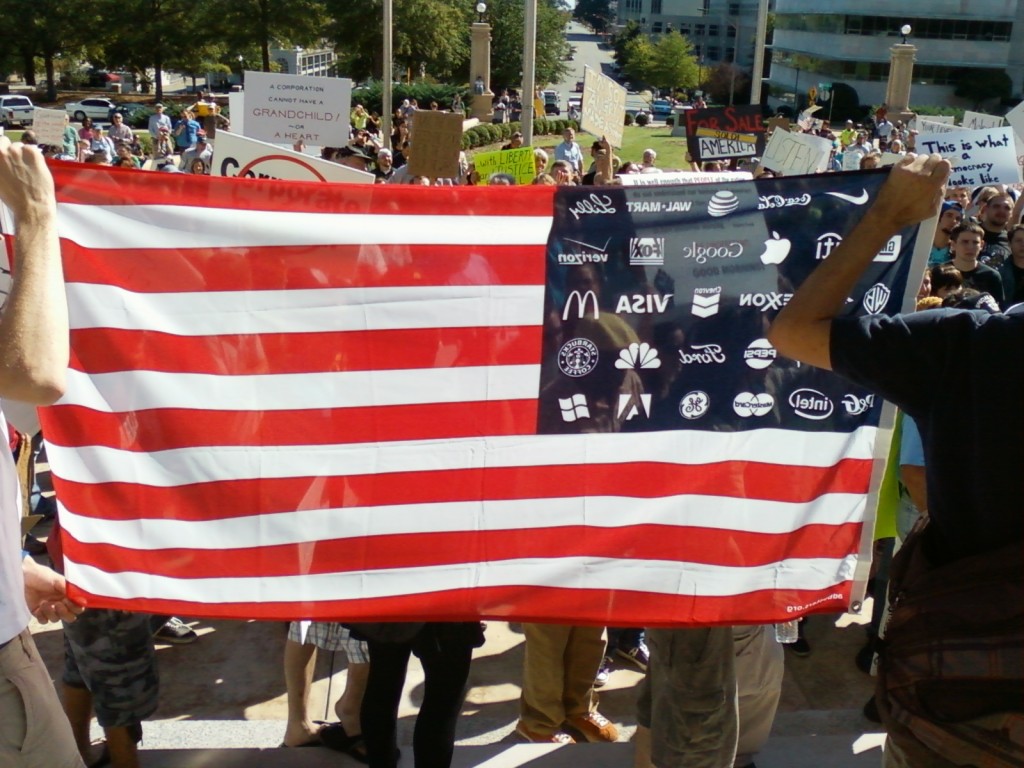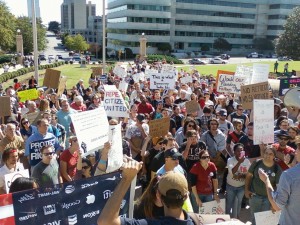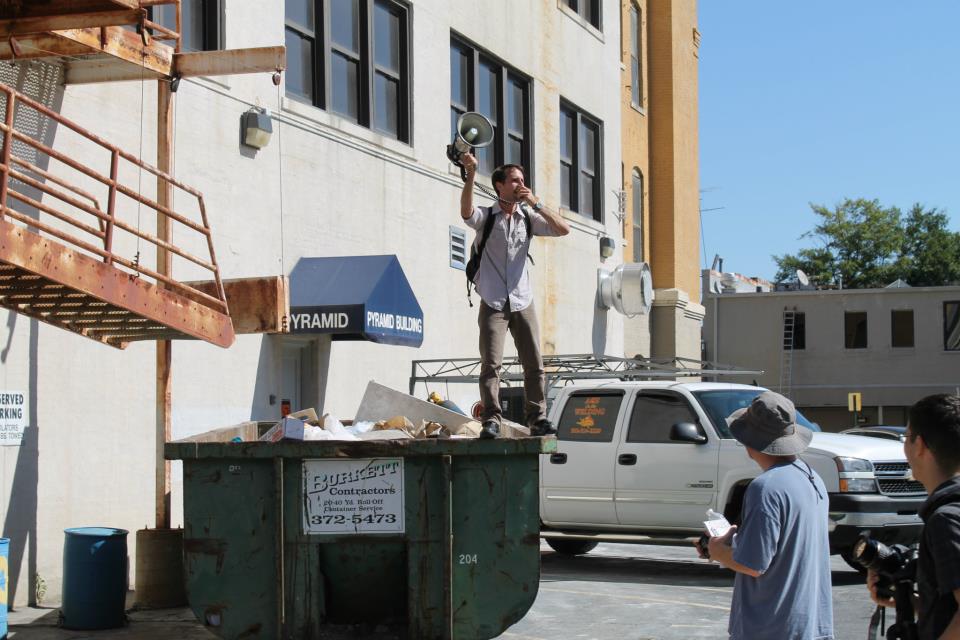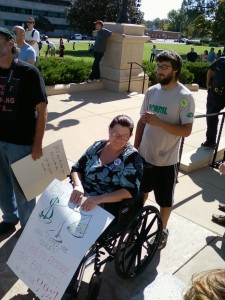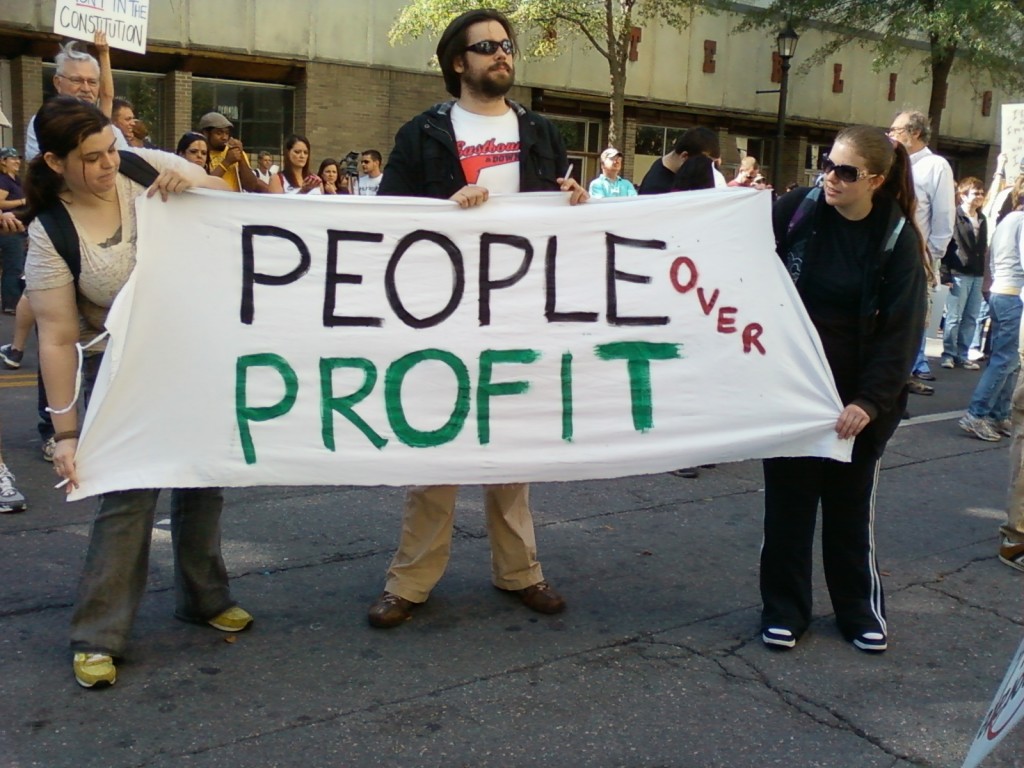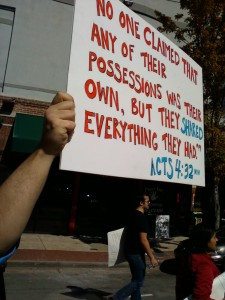Movement the First: To Protest or Not
It started with a spark.
A Canadian spark no less, when the Adbusters Media Foundation came up with an idea to Occupy Wall Street. That spark started the occupation in Liberty Plaza Park Sept. 17, America’s Constitution Day.
At first, few paid attention. But the movement gathered steam and the spark spread to cities across the country and then around the world.
During the time of year normally reserved for the state fair, the spark made it to the Natural State.
***
I stayed up too late Friday night with one of my best friends. He would leave Saturday morning for three weeks of drill with the Arkansas National Guard, which has orders to be ready to go to Afghanistan at a moment’s notice … they just don’t know when they’re going. He’s already been to Iraq twice and would just as soon not see the site of America’s longest war.
I’d told him I’d planned to go to the march, to which he retorted, “As a participant or to cover it?” I hadn’t actually decided yet. So he asked me what was the goal, since he’d heard it was just a bunch of rich kids camping out in New York. Why weren’t they in D.C. instead, if they wanted to fix something with the government?
As I explained, it’s not the government. When 9/11 happened, where did they aim first? At corporate America. That was a terrorist act; this seemed to be something more.
We spent the evening debating whether a protest would actually work. I suggested if I marched in protest, my personal reasons would be to end the Federal Reserve and to get the military out of Afghanistan. Needless to say, we kept it up long after we needed to go to bed.
As I lay down and set my alarm, I noticed it was nearly 2 a.m. That 9 a.m. start would come early.
***
My alarm never went off Saturday morning. I did not notice I needed to move from the M-F setting to the weekend setting after having so many Fat Tires. I snoozed like a baby up until the moment the knock on the door pierced my dream.
I got up and put on the tennis shoes I never wear unless I’m planning to walk some distance. I’d be glad I had remembered to bring them along.
Stepping upstairs in my old house, I made coffee and had a cigarette on the back porch. The crisp air reminded me that I should have brought a jacket. Oh well. After fishing the phone out of my pocket, I realized it was already 9:10 a.m.; I was going to be late.
But late to what?
I’ve attended a protest in Washington, D.C., but this is Arkansas and you just don’t expect as much participation. I even laughed a little to myself as I got ready: it would be tough to have a true “Occupy” movement in Arkansas as few people would miss work to protest. So I guess it’s a good thing they chose a Saturday, which would at least give some folks the opportunity to participate and show their support for the newest movement.
Movement the Second: Protest Around the World
According to various accounts and my own admittedly rough estimates, somewhere between 400 to 600 people marched in the “Occupy Little Rock” protest on a sunny Saturday, Oct. 15 in the Capitol City.
As I walked up to Riverfront Park around a quarter to 10 a.m., I saw more people gathered than I expected. (My initial estimate was about 300-350 people. In hindsight, not everyone started at the park.) Protest organizers bellowed through bullhorns to be certain to pick up the fuschia, green and yellow cards that explained what to do if arrested. The cards provided Miranda Rights and reminded the protesters: “Remember the police are not our enemies.”
“But try to avoid being arrested,” cried one voice.
Though it took two takes to get through it, the organizers steeled their charges by a call-and-response reading of the preamble to the Constitution, i.e.
“We the People of the United States, in order to form a more perfect Union, establish Justice, insure domestic Tranquility, provide for the common defense, promote the general Welfare, and secure the Blessings of Liberty to ourselves and our Posterity.”
From there, the march began with two distinct rally cries as it meandered through the River Market. The first – “We are the 99 percent; You are the 99 percent!” – would be heard throughout the day. The second – “Banks got bailed out, We got sold out!” – would provide the rally cry at the different financial institutions along the way.
People gawked from the windows of the River Market establishments as the group came marching through. Since the protest operated under permit, everything and everyone stopped to let them by.
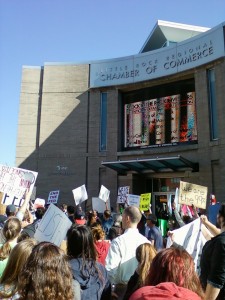
Protesters stop in front of the Little Rock Chamber of Commerce. Organizers told the group that the movement would need the support of the chamber. (Photo by Sitton)
The throng first paused in front of the Little Rock Chamber of Commerce, where it continued to pick up additional marchers.
“We are not here to alienate these people,” one of the organizers announced. “ We need their support.
The movement responded with a new chant: “Human need, not corporate greed!” Granted, it wasn’t quite in unison, but sounded more like chants at Razorback football games when no single director exists, causing a cacophony of sound echoing in the district that brought downtown Little Rock back to life.
If it wasn’t enough that the chant wasn’t together, an additional chanting – “200K is not OK” – made it hard to focus on the speaker urging everyone to buy American instead of foreign-made products.
Then the throng moved again, completely filling Clinton Avenue and starting a new chant: “The people united will never be divided.”
People standing in front of the Peabody Hotel watched the mass pass. Some looked at the marchers as if they were crazy; others filmed the proceedings with cellphones and camcorders. Were they going to show their children?
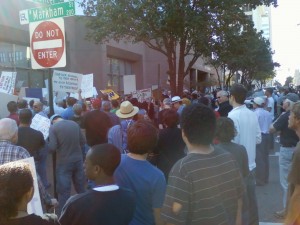
The crowd stops in front of the Stephens Building, which houses Little Rock’s branch of the Federal Reserve. (Photo by Sitton)
Across the street from the Old State House where Bill Clinton celebrated winning the presidency in 1992, the group stopped in front of the Stephens Building, which houses Little Rock’s branch of the Federal Reserve. Many signs in the group suggested America should “End the Fed,” an issue that seems to cut across party lines.
During this stop, I took a good look around to see who it was that was actually protesting the banking industry. I saw a mix of all ages, races and presumably religions. Whole families gathered together in protest. Grandparents stood next to young business-looking men and women with their children by their side. Women pushed toddlers in strollers. This was more than just a group of hippies and college students.
They all gathered to focus on the front of the Stephens Building. Organizer Adam Lansky led chants with his bullhorn aimed toward the windows of a building where most employees weren’t working this weekend. Andrea Ross came from within the crowd to read the movement’s “Manifesto” from her cellphone to the intermittent cheers of the crowd.
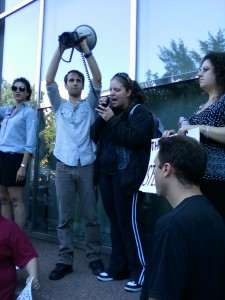
Adam Lansky holds the bullhorn while Andrea Ross reads the Occupy Wall Street manifesto to protesters.
(Note: It took a little digging when I got home, but here’s the same thing she read:)
- They have taken our houses through an illegal foreclosure process, despite not having the original mortgage.
- They have taken bailouts from taxpayers with impunity, and continue to give Executives exorbitant bonuses.
- They have perpetuated inequality and discrimination in the workplace based on age, the color of one’s skin, sex, gender identity and sexual orientation.
- They have poisoned the food supply through negligence, and undermined the farming system through monopolization.
- They have profited off of the torture, confinement, and cruel treatment of countless animals, and actively hide these practices.
- They have continuously sought to strip employees of the right to negotiate for better pay and safer working conditions.
- They have held students hostage with tens of thousands of dollars of debt on education, which is itself a human right.
- They have consistently outsourced labor and used that outsourcing as leverage to cut workers’ healthcare and pay.
- They have influenced the courts to achieve the same rights as people, with none of the culpability or responsibility.
- They have spent millions of dollars on legal teams that look for ways to get them out of contracts in regards to health insurance.
- They have sold our privacy as a commodity.
- They have used the military and police force to prevent freedom of the press.
- They have deliberately declined to recall faulty products endangering lives in pursuit of profit.
- They determine economic policy, despite the catastrophic failures their policies have produced and continue to produce.
- They have donated large sums of money to politicians, who are responsible for regulating them.
- They continue to block alternate forms of energy to keep us dependent on oil.
- They continue to block generic forms of medicine that could save people’s lives or provide relief in order to protect investments that have already turned a substantial profit.
- They have purposely covered up oil spills, accidents, faulty bookkeeping, and inactive ingredients in pursuit of profit.
- They purposefully keep people misinformed and fearful through their control of the media.
- They have accepted private contracts to murder prisoners even when presented with serious doubts about their guilt.
- They have perpetuated colonialism at home and abroad.
- They have participated in the torture and murder of innocent civilians overseas.
- They continue to create weapons of mass destruction in order to receive government contracts.
Ross finished the statement by adding that this group was occupying Little Rock. Lansky took the reins and suggested an outlet for the crowd’s frustration: “How about we boo these people?”
A chorus of boos echoed up and down Center Street.
Security personnel stood outside of the Stephens Building, some with looks of bewilderment and others with looks of disgust. But I did not see any interaction between them and the protesters. I stopped an officer to ask if there had been any problems yet, but he replied that no problems had occurred at this point.
The protest continued up Center Street with Lansky asking the group, “Tell me what Democracy looks like,” and the group responding, “This is what Democracy looks like.”
The group stopped next at Bank of America. Organizers reminded the protesters that the government thought this bank was one of the institutions “too big to fail.” This brought a round of boos. One gentleman offered to cut up his Bank of America debit card since the bank had decided to charge a $5 monthly fee for its use.
As he cut it up, the crowd cheered. While watching the proceedings, a sign caught my eye: “I’m so angry I made a sign.”
A reporter I know stood away from the crowd taking notes, so I stopped to see what his estimate of the crowd size might be. He said he and another reporter guessed between 500-600. He had spoken to people who had driven from as far as Russellville and Hot Springs to join the Little Rock rally.
I returned to the gathering as the crowd began to chant, “Corporations are not people,” presumably in reference to the Citizens United decision by the Supreme Court.
An organizer asked the crowd, “How many of you paid $1 or more in income taxes this year? Uncle Money Bags (i.e. Bank of America) paid nothing! They tell us we don’t pay taxes to give you jobs!”
And the crowd responded with a new chant: “Where are the jobs?! Where are the jobs?!”
As the crowd began its trek to the capitol, a new chant emerged: “Whose streets? Our streets.”
I’d moved to the sidewalk by then, nearly tripping over a dog wearing a shirt pinned with a sign, “I am the 99 percent.” I stopped for a picture, then returned to the march.
The mass went up Capitol Avenue past the U.S. Court of Appeals building and the Federal Building. Stepping to the side, I tried again to estimate the size of the crowd. Spread over all four lanes of traffic, the group still filled about two-to-three blocks walking side by side.
In front of the Federal Building, Lansky suddenly stopped near circling officers to exhort the crowd to step on the public sidewalk, but to stay off the grass. Officers moved out of the crowd’s way and the mass surged forward.
One protester came forward to speak, telling everyone, “You are the most beautiful human beings I’ve ever seen in my life!” He gave way to a woman who attempted to speak to the crowd through the bullhorn, though she could still barely be heard. She read from Paul Krugman’s Oct. 6 column, “Confronting the Malefactors.”
Shortly after, another protester used his cellphone to re-read the Manifesto to the assembly, though he had to be circled to diffuse the glare from the sun. As he tripped over some of the words, one of the organizers told the crowd, “It’s really small font, guys.”
Having already heard this once, I moved to the back of the crowd and started looking at the police presence. At first, I concluded the Little Rock Police Department had effectively shut off the march from any prying eyes. But then I thought, “What prying eyes?” Nobody would be working at the Federal Building or the Court of Appeals on a Saturday anyway.
I found it interesting that a bevy of officers stood underneath the shade of a small grove of trees in a parking lot adjacent to the Federal Building. They seemed to be there if needed, but content to remain far enough away to not be infected.
The chant “This is no recession, this is a robbery!” caught my attention again as I stopped to talk with a good friend who told me he had yelled himself into a headache. The group moved again, away from the Federal Building and now toward the State Capitol.
Being in the back of the group, I noticed members picking up trash when others dropped it. Of course, I assumed others dropped it; maybe they were just picking up the trash?
I did not feel like running to the front of the march to get pictures of the group coming, but from the rear I shot photos with my cellphone that provided some idea of how big the group actually was. It reminded me of a tide moving on a beach, in this case, uphill.
Once reaching the Capitol steps, the group fanned out. Individuals young and old took turns before the group reading their grievances:
- A man named Sam asked the crowd, “If corporations are human, why aren’t they paying taxes like we are?”
- Another speaker said American citizens have the right to take back America. “I will fight for our children’s freedom,” which led to the assembly responding “Humans first. Humans first.”
- A lady named Lisa lamented, “They say we’re a bunch of angry kids. Hey, look around. I just ask of you to stay in with us. It’s not just today. These problems have been going on a long time.”
A black man named Michael gave thanks to God for all of the people who were participating. He decried the future of the children if Arkansans kept electing “crazy people” into office. “Let’s quit looking at how we disagree, but instead look at how we can come together to make this a great America!”
- Damien, a professed veteran, said he was not speaking to those in attendance. “I am talking to the rest of Arkansans who do not realize they are part of the 99 percent.” He exhorted the crowd to explain to their neighbors and friends why they are part of the afflicted.
- A young man named Caleb issued a “Call to Reason,” suggesting citizens put aside their differences to focus on their mutual interests “under attack” and asked for those not in the movement to, “Respect us.” He claimed solidarity with others across the state, across the nation and around the world. “We are the 99 percent and we are not afraid!” he bellowed as his voice gave out.
- A former New Orleans’ resident smiled over the crowd and said, “Finally I see that we have waken up!”
Other speakers called out the Citizens United decision that found corporations have the same rights as people. At least two speakers claimed to be high school students. One speaker had the last name of Stephens but noted she was not a part of “that” Stephens’ family.
By this time, my stomach had started to growl. It seemed the speeches would just continue on and on, each with a different personal agenda. I had plenty of pictures filling my cellphone, and the battery was dying. (Note: Apparently the media and protesters weren’t the only ones taking pictures. At least one person posting to facebook caught a police officer taking pictures of the crowd, too.)
As the crowd began to dwindle, a family of my friends started the trek back and I joined them, reviewing the march as we walked.
When we reached Capitol and Broadway, I ran into a high school teammate now working for LRPD. We exchanged pleasantries and talked about getting older and bigger. I moved along to catch the light and walk across the street. We had made it down Capitol a few blocks when I noticed police cars and motorcycles flying past. One of the unmarked cruisers carried LRPD’s Public Information Officer, Lt. Terry Hastings.
I walked up to the cruiser after he turned around and asked if there had been any problems.
“No problems at all,” he replied. “It’s been a good group.”
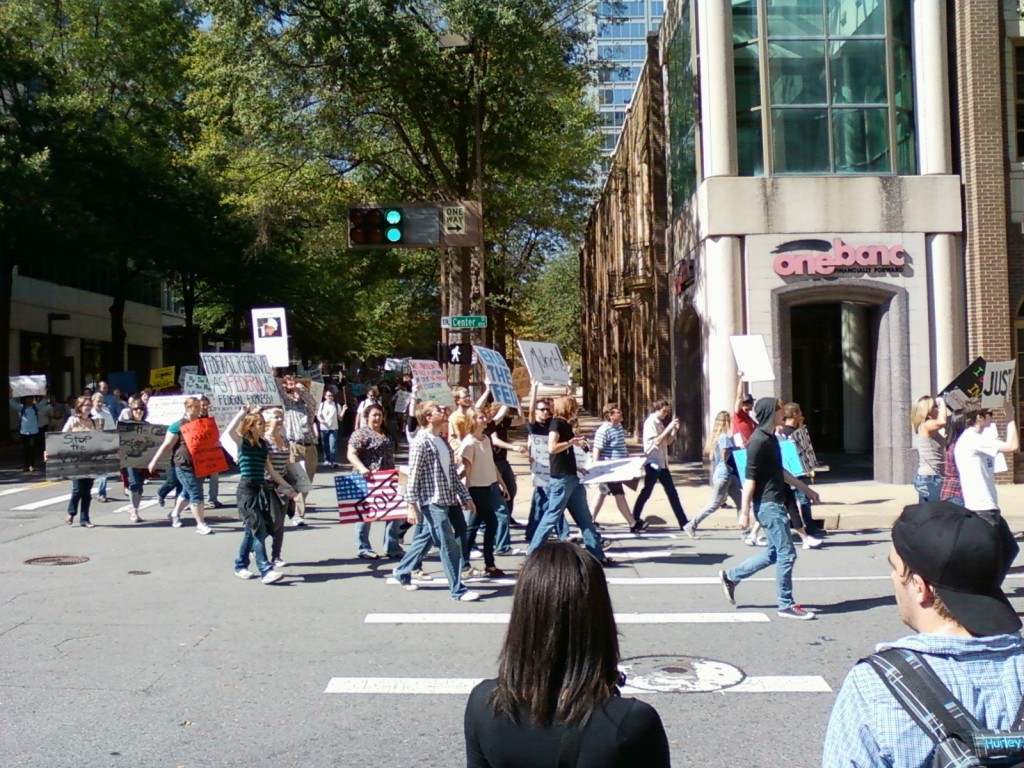
Protesters return along the same route down Center Street towards the River Market. (photo by Sitton)
About this time I noticed the march returning through the same route. I found it unusual as previous marches I’d covered ended at a destination and then protestors found their own way back. I joined the group again as it turned onto Center Street.
Lansky ran past me, shouting through his bullhorn and urging the mass onward. At one point, he jumped on top of a dumpster. I tried taking a photo, but the memory was full.
If anything, the group actually got louder as it turned back onto Clinton Avenue and headed back through the River Market. “Banks got bailed out; We got sold out!” bounced off the walls of the ritzy hotels lining the street.
I stopped another motorcycle officer to ask if there had been any problems on the return. “Not a one,” he replied.
The group finished marching back to Riverfront Park and immediately disbanded. Some stopped to eat, others headed for their automobiles. I headed home.
Movement the Third: Putting It into Perspective
I’ve lived in Arkansas about 36 of my 42 years. I kept turning it over in my mind on the drive back to Monticello that I never expected a march to be so big.
Waking up Sunday morning, I found the Occupy Jonesboro movement attracted about a dozen people, according to the Jonesboro Sun. According to 4029TV in Western Arkansas, hundreds showed up in Fayetteville to join the protest. I couldn’t find anything about Occupy Hot Springs, though its facebook site seemed to indicate some of those folks came to Little Rock.
The Natural State does not contain the population of other places; New York City and Los Angeles claim more residents. Instead of a lot of people, it contains a lot of woods, water and farmland. No offense to my fellow Arkansans, but when I think of protest, Arkansas does not seem to be the place.
So I decided to do a little research and found Arkansas occasionally hosts a protest or two. Looking back through the beauty of Lexis-Nexis, we can see what they were about over the last quarter century.
Amazingly, I found more than expected. As reported in the news, Arkansas has hosted protests from as few as three people (NORML’s “tax-me” protest in 1991) to more than 3,000 (teachers protesting competency exams in 1985).* An unofficial record would be the estimated 5,000+ that attended the 2011 “March for Life” protest to the State Capitol.
Eighteen disabled protesters shackled themselves inside then-Gov. Bill Clinton’s office in 1992 until he restored financing that helped disabled people live at home. Six years later, 250 protesters angry over a lack of jobs for welfare recipients crashed the Southwest Regional Civil Rights conference only to find then-Gov. Mike Huckabee had already left.
On the left, the Arkansas Community Reform Organizations Now (i.e. ACORN) has led protests against a lack of adequate city housing in Little Rock, a lack of jobs for welfare recipients (targeting Huckabee), discriminatory lending by banks and a need for a minimum wage increase. State-sanctioned executions brought out protestors in ’89, ‘90’ 91, ’97, ’98, ’99, ‘01 and the double execution in ’04.
On the right, the 1989 “Arkansas Tea Party” protest coinciding with the beginning of the legislative session brought out 150 people; a year later, rainy conditions keep the protest to 20. More than 60 protesters descended on two abortion clinics in 1994, but were outnumbered by the police, which arrested 30, including two teenage girls. An annual “March for Life” will enter its 34th year in 2012.
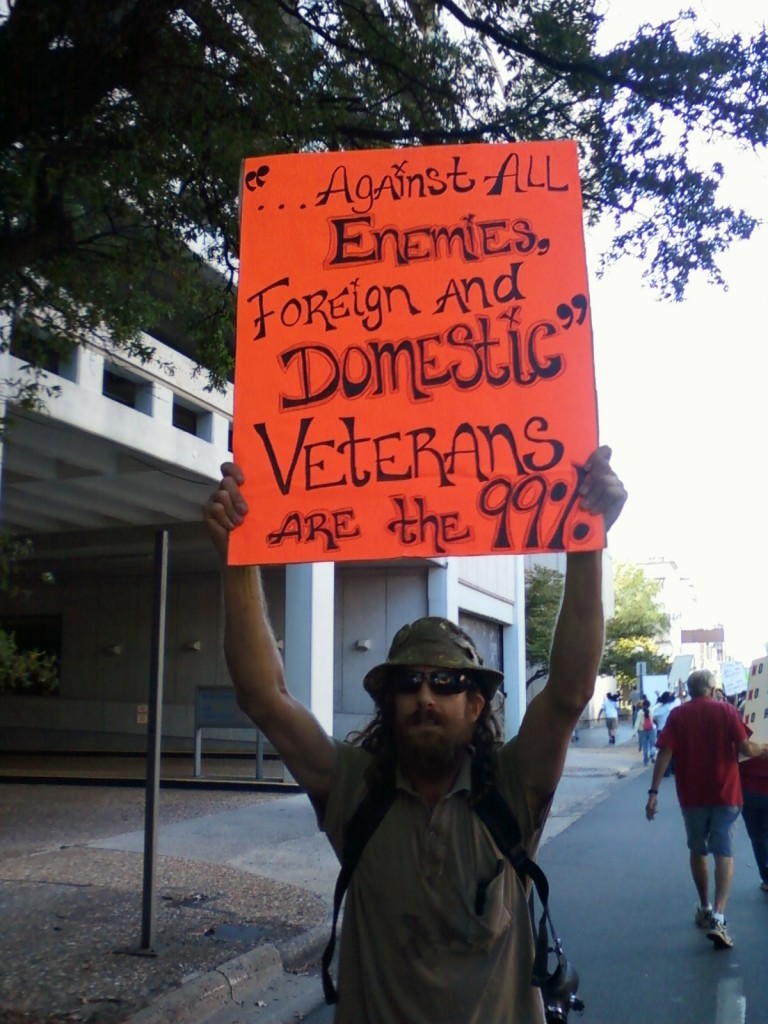
The protest brought together people of all ages, races, religions and walks of life, including this veteran. (photo by Sitton)
War brings out protesters. Nine women disrobed a few blocks off the Fayetteville campus as part of a “Code Pink” protest in 2003. Hundreds of students on multiple college campuses in the state joined the “Books Not Bombs” protest that same year, including more than 300 at the University of Arkansas’ Fayetteville campus. More than 600 people gathered at the State Capitol (a month after 250 gathered at the same place) to protest America entering a war with Iraq. Nearly 50 protesters stood near a busy West Little Rock intersection to protest the wars in Iraq and Afghanistan in 2007.
Arkansans have protested burning PCBs in El Dorado and hazardous waste incineration at Jacksonville’s Vertac plant. Arkansans have protested against U.S. aid to Nicaraguan rebels, the state’s employee grievance procedure, experimental chemical injections to kill unwanted trees, testing chemical products on animals, fracking to release natural gas and a Nelly concert at Arkansas State University.
Not counting the war, abortion or execution protests, many protests have not stopped their intended target:
- Communication workers protested against Southwestern Bell and AT&T’s new electronic systems that were feared to be replacing operators: they did.
- Twenty-five “Trust the People” group members in Fayetteville protested against the Electoral College process after the 2000 presidential election; Bush still won and the process remains.
- The fracking protest did not slow down the process or the money made from that process.
Regardless of whether it works or not, American citizens claim the right to protest as part of the First Amendment. Whether we agree with them or not, they have the right to do so.
Sometimes government would like to keep the protesters from doing so, e.g. Boone County banned a military funeral protest by the Westboro Baptist Church of Topeka, Kan., in 2010. But Say McIntosh also produced headlines across the state for trying to burn the American flag on the steps of the State Capitol in protest of racial discrimination. When he invoked his right to protest, many Arkansans called it nothing more than a political stunt.
Back to the present: the Arkansas Democrat-Gazette reported about 500 Tea Party supporters protested President Obama’s budget and government spending in 2009. Sunday it reported 500 participated in the Occupy Little Rock protest. Does that make it a wash? I’d counter that when Arkansans get riled enough to start protesting about something not in their back yard, it’s time to pay closer attention.
Critics of the current round of protests claim the message is too splintered to be understood; critics of the Tea Party protests claim they basically used a talking points memo. Media outlets like ABC News and the Economic Times have started asking if the current movement can continue without leaders; what they’re actually asking is who can our standard sources be so we don’t have to continue interviewing so many regular Joes and Jills.
I believe the strength of this movement is due to its decentralization. The people of America are not only mad and not only tired of footing the bills for the failures of banks and businesses that they’re being asked to bail out.
Few are willing to say it, but I believe Americans are tired of the country moving towards fascism. It’s not a new idea: Thomas Jefferson railed against a national bank following the American Revolution. Andrew Jackson fought the banks as president. Franklin Delano Roosevelt claimed, “The liberty of a democracy is not safe if the people tolerate the growth of private power to the point where it becomes stronger than their democratic state itself. That, in its essence, is fascism.”
Will the Occupy movements lose ground? Will America become fascist as the leaders they elect end up supporting bills that benefit the corporations instead of the populace? Will America ever rid itself of the Federal Reserve? Truly, time will tell.
But as one friend noted when discussing Saturday’s march (which he didn’t attend): you cannot ignore the working class and expect things to get better.
“They need to look back to 1789,” he said. I thought he was speaking about the switch from the Articles of Confederation to the U.S. Constitution. He replied that he actually meant the French Revolution.
And we all know what happened when that spark lit a fire.
-30-
*Last edited 9:16 p.m. 10/16/11
Correction: The original post suggested a high count of 3,000 protesters. This was updated to reflect the 5,000 marchers from January 2011.
